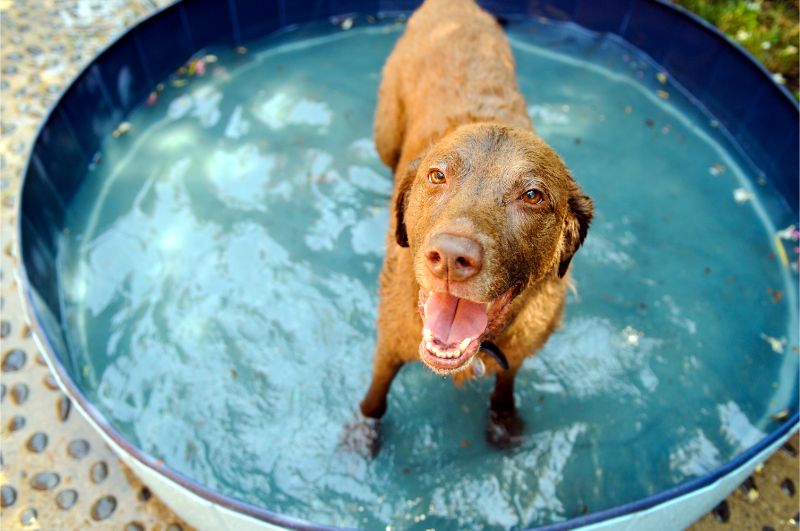Splish Splash: Where Should Your Dog Swim?

For dogs that love the water, going for a swim on a hot day is a real treat and one of the best parts of summer! However, finding a safe place for your pooch to splash around in is another issue entirely. Should your dog swim in a chlorinated pool? What about a local lake or river? Is it safer to just fill up a kiddie pool in the backyard?
At Lone Tree Veterinary Medical Center, we want pets to get plenty of exercise and bonding time with their owners. With careful observation, appropriate safety measures, and a little common sense, you might find swimming to be an enjoyable activity for you and your furry pal!
Where Can My Dog Swim Safely?
Let’s take a look at the pros and cons of some common swimming spots for dogs:
- Swimming pool – As long as the chemicals in a swimming pool have been properly maintained and are pH balanced, pools are generally safe for dogs – just make sure they don’t drink the water. Teach your dog how to get out of the pool safely by using the stairs or ladder, and never leave a dog in or near a pool unsupervised. It’s also a good idea to thoroughly rinse your dog off with a gentle water spray to rid the haircoat and skin of any pool chemical residue.
- Kiddie pool – A small kiddie pool can be a good way to safely introduce your dog to water or to play with your dog in water, especially if your dog is a smaller breed. Be sure the water is fresh and clean, and that you stay with your dog while it is in the water. As with a child, a dog can drown in even shallow water if panicked or exhausted. Always stop the swim when your dog starts looking tired or doesn’t seem to be enjoying it.
- Lake – Larger lakes can be a fun and generally safe place for dogs. Avoid lakes with algae on the surface, as this can be toxic, causing ear/eye irritation and GI upset. Watch the shore for hazardous debris, and steer clear of any water that appears stagnant, dirty, or contains debris or trash. It’s a must to put a life jacket on your dog while boating or swimming in a lake. Also, do not let your dog swim too far away from you where a rescue would be difficult if your dog got into trouble or became tired.
- River – Fresh, flowing water can seem like an ideal place to swim, but rivers are an ever-changing landscape – an area that looks safe to swim in one day can be dangerous the next. Currents and undertows can also be treacherous, and some areas of a river can be surprisingly deep. Any dog can get into serious trouble if caught up in a current and swept away. Even rivers with a shallow area and long bank that seem safe can be a problem if a dog swims further out. It is best to avoid rivers as a whole. If you are going to hike or be near a river with your dog, it’s a good idea for your dog to be wearing a life jacket, just in case it ends up in the water. Also, keep your dog away from rivers after floods, heavy rains, or snowmelt runoff.
- Stream/creek – Small shallow streams or creeks, may not be deep enough for actual swimming, but they can make the perfect place for a quick splash cool-down while on a hike. Watch for sharp objects in or alongside a stream, such as broken glass, sharp sticks, or rocks.
- Pond – Due to their small size, ponds tend to accumulate algae and other debris, and may have higher amounts of bacteria from animal feces and other sources. Unless the pond looks exceptionally clean and clear, it’s probably best to skip it altogether.
Safety Reminders
Access to fresh water, protection from the heat, and cleanliness should be top priorities anytime you take your dog for a swim.
- Take lots of breaks in the shade and stop the swimming completely if your dog starts to look tired.
- Offer fresh water for drinking to keep your pup hydrated and to discourage drinking directly from rivers, lakes, streams or pools.
- For its safety, any dog that swims should be trained to consistently respond to your “come here”, “leave it”, and “stay” commands, as this could save its life in a dangerous situation.
- Thoroughly rinse your dog with clean water and towel dry after each swim. Make sure to thoroughly dry off the ears to prevent infection.
- Make sure that your dog’s vaccinations, including leptospirosis and parasite protection, are up-to-date before swimming, especially if other dogs will be present. While fleas, ticks, heartworm, and lice are always a concern, leptospirosis is transmitted specifically through water contaminated by an infect animal and can also be transmitted to people.
- Dogs should ALWAYS wear a life jacket while learning to swim or regularly swimming in any body of water. Only a well-trained and skilled canine swimmer should be allowed to enter a lake or pool without one and, then, only for short periods of time and close to the shore. The last thing you want is to have to go in to rescue your dog, which could place you both at risk or worse. Life jackets for dogs come in a variety sizes and shapes.
- NEVER leave your dog unsupervised around any body of water. Dogs can and do drown if panicked, exhausted or just not able to swim to safety on their own.
Please don’t hesitate to contact us for more information on caring for your dog, or to schedule an appointment for your dog. We love helping dogs stay healthy so they can enjoy the outdoors with their people. Happy splashing!

